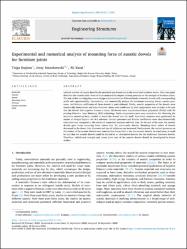| dc.contributor.author | Kuşkun, Tolga | |
| dc.contributor.author | Smardzewski, Jerzy | |
| dc.contributor.author | Kasal, Ali | |
| dc.date.accessioned | 2020-11-20T16:49:49Z | |
| dc.date.available | 2020-11-20T16:49:49Z | |
| dc.date.issued | 2021 | |
| dc.identifier.issn | 0141-0296 | |
| dc.identifier.uri | https://doi.org/10.1016/j.engstruct.2020.111351 | |
| dc.identifier.uri | https://hdl.handle.net/20.500.12809/6186 | |
| dc.description.abstract | Limited number of papers describe the practical use of auxetics in the wood and furniture sector. Only one paper describes the auxetic nails. None of them analyzed the impact of using auxetics on the strength of furniture joints. The aim of this investigation was to design and manufacture different kinds of auxetic dowels with corresponding muffs and experimentally, theoretically, and numerically analyze the minimum mounting forces, contact pressures, and friction coefficients of these dowels in particleboard. Firstly, auxetic properties of the dowels were numerically determined, and then obtained values were confirmed by real compression tests in order to be sure that the dowels had negative Poisson's ratios. All dowels were manufactured from polyamide (PA12) with 3D printing Selective Laser Sintering (SLS) technology. Static compression tests were carried out for obtaining the minimum mounting force needed to insert the dowel into the muff. Numerical analyses were performed by means of Abaqus/Explicit v6.14-2 software. Contact pressures and friction coefficients were also theoretically calculated and compared to the results of numerical analyses and real tests. At the end of the tests, the auxetic dowels gave lower mounting force values than the non-auxetic dowels. Mounting force values of dowels decreased as the dowel hole diameter and size of inclusions are increased. Furthermore, the contact pressures on the surface of the auxetic dowels were considerably lower than in the non-auxetic dowels. In conclusion, it could be said that the auxetic dowels could be utilized as an alternative fastener for the traditional furniture dowels. Therefore, withdrawal strength and corner joint tests of the auxetic dowels should be investigated in future studies. © 2020 The Author(s) | en_US |
| dc.description.sponsorship | Ministerstwo Nauki i Szkolnictwa Wy?szego | en_US |
| dc.description.sponsorship | The paper was financed also within the framework of the Ministry of Science and Higher Education programme “Regional Initiative of Excellence” in years 2019-2022, Project No. 005/RID/2018/19. This study was also supported by Scientific and Technological Research Council of Turkey (TUBITAK) under the Science Fellowships and Grant Programs with the application no. 1059B191800913. Part of the computations was performed using computers of the Poznan Supercomputing and Networking Center. | en_US |
| dc.item-language.iso | eng | en_US |
| dc.publisher | Elsevier Ltd | en_US |
| dc.item-rights | info:eu-repo/semantics/openAccess | en_US |
| dc.subject | Auxetic | en_US |
| dc.subject | Contact pressure | en_US |
| dc.subject | Dowel | en_US |
| dc.subject | FEM | en_US |
| dc.subject | Friction | en_US |
| dc.subject | Mounting force | en_US |
| dc.title | Experimental and numerical analysis of mounting force of auxetic dowels for furniture joints | en_US |
| dc.item-type | article | en_US |
| dc.contributor.department | MÜ, Teknoloji Fakültesi, Ağaç İşleri Endüstri Mühendisliği Bölümü | en_US |
| dc.contributor.institutionauthor | Kuşkun, Tolga | |
| dc.contributor.institutionauthor | Kasal, Ali | |
| dc.identifier.doi | 10.1016/j.engstruct.2020.111351 | |
| dc.identifier.volume | 226 | en_US |
| dc.relation.journal | Engineering Structures | en_US |
| dc.relation.publicationcategory | Makale - Uluslararası Hakemli Dergi - Kurum Öğretim Elemanı | en_US |


















